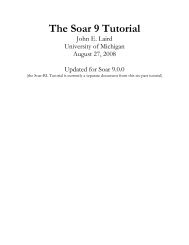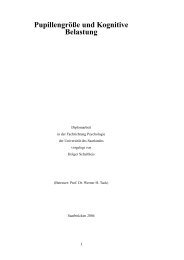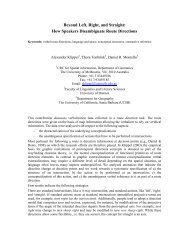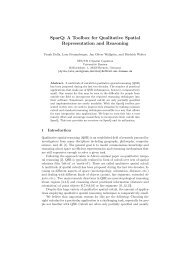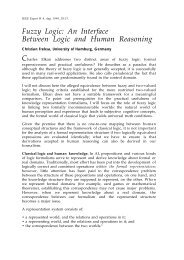Schematic Maps for Robot Navigation - the Cognitive Systems Group
Schematic Maps for Robot Navigation - the Cognitive Systems Group
Schematic Maps for Robot Navigation - the Cognitive Systems Group
Create successful ePaper yourself
Turn your PDF publications into a flip-book with our unique Google optimized e-Paper software.
in<strong>for</strong>mation, spatial relations in <strong>the</strong> map can be directly applied to <strong>the</strong> environment<br />
and vice versa, in many cases. All maps distort spatial relations to some extent, <strong>the</strong><br />
most obvious distortion being <strong>the</strong> distortion due to scale trans<strong>for</strong>mation (Barkowsky<br />
& Freksa, 1997). Most spatial distortions in maps are gradual distortions. No<br />
translation of spatial in<strong>for</strong>mation through symbol interpretation is required as in <strong>the</strong><br />
case of natural language descriptions.<br />
The strong spatial correspondence between maps and spatial environments has<br />
specific advantages when dealing with spatial perception; in our case <strong>the</strong> robot is<br />
equipped with sensors that determine <strong>the</strong> spatial location of objects to per<strong>for</strong>m its<br />
navigation task. The distortions obtained in <strong>the</strong> sensor readings may share properties<br />
with <strong>the</strong> distortions we get in map representations; thus, <strong>the</strong> same interpretation<br />
mechanisms may be used <strong>for</strong> <strong>the</strong> interpretation of <strong>the</strong> maps and of <strong>the</strong> sensor readings.<br />
In <strong>the</strong> setting described, maps can be constructed from <strong>the</strong> spatial relations in <strong>the</strong><br />
environment by a human overlooking <strong>the</strong> environment or by a robot moving through<br />
<strong>the</strong> environment. The human can convey instructions to <strong>the</strong> robot using maps. In<br />
solving its task, <strong>the</strong> robot can match spatial relations in <strong>the</strong> map against spatial<br />
relations in <strong>the</strong> environment. And <strong>the</strong> robot can communicate back to <strong>the</strong> human<br />
instructor by using a map. This provides us with a rich environment to study <strong>for</strong>mal<br />
properties of different maps and practical map use. Figure 1 indicates <strong>the</strong><br />
communication relations between <strong>the</strong> human and <strong>the</strong> robot on one hand and <strong>the</strong><br />
spatial correspondence between <strong>the</strong> environment and <strong>the</strong> map on <strong>the</strong> o<strong>the</strong>r hand.<br />
spatial environment<br />
human map robot<br />
Fig. 1. Spatial communication relations between human, map, robot, and environment (thick<br />
arrows). Thin arrows indicate spatial correspondence relations between map and spatial<br />
environment<br />
3 Qualitative Spatial Knowledge <strong>for</strong> <strong>Navigation</strong> Tasks<br />
Depending on <strong>the</strong> class of tasks to be per<strong>for</strong>med, different abstractions of spatial<br />
knowledge may be useful. To determine what type of knowledge may be most useful<br />
to solve navigation tasks, let us consider two extreme cases: (1) <strong>the</strong> robot knows<br />
everything about its spatial environment and (2) <strong>the</strong> robot knows nothing about its<br />
spatial environment. In <strong>the</strong> first case, <strong>the</strong> robot does not require perception as it can<br />
navigate entirely on <strong>the</strong> basis of <strong>the</strong> available knowledge. (We can dismiss this case<br />
on <strong>the</strong> basis of unattainability of complete correct knowledge, in particular in dynamic



